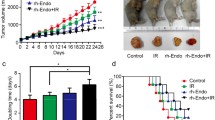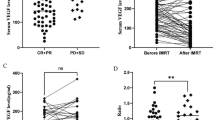Abstract
The growth of solid tumors requires angiogenesis to provide oxygen and nutrients and to support cell proliferation. The switch from an avascular to a vascular phenotype is typically related to acceleration of tumor growth. Anti-angiogenic therapy is becoming a very promising way for malignant tumors. Meanwhile, malignant tumor cells themselves were able to develop the formation of cell-lined vessels that contribute to tumor neovascularization and supply the nutrients and oxygen, which is called vasculogenic mimicry (VM). However, the molecular mechanism of VM remains unclear. The purpose of this study was to investigate the efficacy of the novel recombinant human endostatin (rh-Endo) protein combined with radiotherapy on human esophageal squamous cell carcinoma (ESCC) cell lines Eca-109 and TE13. Our results showed that rh-Endo combined with radiotherapy significantly inhibited the proliferation, migration, invasion, and VM of human esophageal cancer cells in a dose-dependent manner; however, it has no direct effect on apoptosis of carcinoma cells, which indicated that rh-Endo combined with radiotherapy significantly changed the microenvironment of esophageal carcinoma, and played an important role in preventing distant metastasis. Our findings suggested that rh-Endo inhibited the metastasis of esophageal cancer and the activation of AKT pathway, and the down-regulation of epithelial–mesenchymal transition (EMT) may be associated with such effect of rh-Endo. These results also supported the bright prospect of rh-Endo combined with radiotherapy for clinical applications in the future.





Similar content being viewed by others
Abbreviations
- ESCC:
-
Esophageal squamous cell carcinoma
- RT:
-
Radiotherapy
- rh-Endo:
-
Recombinant human endostatin
- NSCLC:
-
Non-small-cell lung cancer
- EMT:
-
Epithelial–mesenchymal transition
- VM:
-
Vaculogenic mimicry
- DMSO:
-
Dimethyl sulfoxide
- DMEM:
-
Dulbecco’s modified eagle medium
- FITC:
-
Fluorescein isothiocyanate
- CCk-8:
-
Cell counting kit-8
- PTEN:
-
Phosphatase and tensin homolog deleted on chromosome ten
- Akt:
-
Protein kinase B PKB
- GSK-3β:
-
Glycogen synthase kinase 3β
- GAPDH:
-
Glyceraldehyde-3-phosphate dehydrogenase
References
Yu S, Yang CS, Li J, You W, Chen J, Cao Y, et al. Cancer prevention research in china. Cancer Prev Res (Phila). 2015;8:662–74.
D’Journo XB, Thomas PA. Current management of esophageal cancer. J Thorac Dis. 2014;6 Suppl 2:S253–64.
Jain RK. Normalizing tumor vasculature with anti-angiogenic therapy: a new paradigm for combination therapy. Nat Med. 2001;7:987–9.
Carmeliet P, Jain RK. Angiogenesis in cancer and other diseases. Nature. 2000;407:249–57.
Behl T, Kaur I, Goel H, Kotwani A. Significance of the antiangiogenic mechanisms of thalidomide in the therapy of diabetic retinopathy. Vascul Pharmacol 2015.
Salza R, Oudart JB, Ramont L, Maquart FX, Bakchine S, Thoannes H, et al. Endostatin level in cerebrospinal fluid of patients with Alzheimer’s disease. J Alzheimers Dis. 2015;44:1253–61.
Al-Rawi S, Meehan-Andrews T, Bradley C, Al-Rawi J. Novel benzoxazines as inhibitors of angiogenesis. Investig New Drugs. 2015;33:45–52.
Xu X, Mao W, Chen Q, Zhuang Q, Wang L, Dai J, et al. Endostar, a modified recombinant human endostatin, suppresses angiogenesis through inhibition of Wnt/beta-catenin signaling pathway. PLoS One. 2014;9:e107463.
Sun T, Zhao N, Zhao XL, Gu Q, Zhang SW, Che N, et al. Expression and functional significance of Twist1 in hepatocellular carcinoma: its role in vasculogenic mimicry. Hepatology. 2010;51:545–56.
Kong D, Li Y, Wang Z, Sarkar FH. Cancer stem cells and epithelial-to-mesenchymal transition (EMT)-phenotypic cells: are they cousins or twins? Cancers (Basel). 2011;3:716–29.
Kalluri R, Weinberg RA. The basics of epithelial-mesenchymal transition. J Clin Invest. 2009;119:1420–8.
Polyak K, Weinberg RA. Transitions between epithelial and mesenchymal states: acquisition of malignant and stem cell traits. Nat Rev Cancer. 2009;9:265–73.
Hassan H, Greve B, Pavao MS, Kiesel L, Ibrahim SA, Gotte M. Syndecan-1 modulates beta-integrin-dependent and interleukin-6-dependent functions in breast cancer cell adhesion, migration, and resistance to irradiation. FEBS J. 2013;280:2216–27.
Meng MB, Jiang XD, Deng L, Na FF, He JZ, Xue JX, et al. Enhanced radioresponse with a novel recombinant human endostatin protein via tumor vasculature remodeling: experimental and clinical evidence. Radiother Oncol. 2013;106:130–7.
He E, Pan F, Li G, Li J. Fractionated ionizing radiation promotes epithelial-mesenchymal transition in human esophageal cancer cells through PTEN deficiency-mediated akt activation. PLoS One. 2015;10:e126149.
Ricci-Vitiani L, Pallini R, Biffoni M, Todaro M, Invernici G, Cenci T, et al. Tumour vascularization via endothelial differentiation of glioblastoma stem-like cells. Nature. 2010;468:824–8.
Dejana E. The role of wnt signaling in physiological and pathological angiogenesis. Circ Res. 2010;107:943–52.
Otrock ZK, Mahfouz RA, Makarem JA, Shamseddine AI. Understanding the biology of angiogenesis: review of the most important molecular mechanisms. Blood Cells Mol Dis. 2007;39:212–20.
Jung IL, Kang HJ, Kim KC, Kim IG. PTEN/pAkt/p53 signaling pathway correlates with the radioresponse of non-small cell lung cancer. Int J Mol Med. 2010;25:517–23.
Bai X, Li X, Tian J, Zhou Z. Antiangiogenic treatment diminishes renal injury and dysfunction via regulation of local AKT in early experimental diabetes. PLoS One. 2014;9:e96117.
Kim ES, Herbst RS. Angiogenesis inhibitors in lung cancer. Curr Oncol Rep. 2002;4:325–33.
Cui C, Mao L, Chi Z, Si L, Sheng X, Kong Y, et al. A phase II, randomized, double-blind, placebo-controlled multicenter trial of Endostar in patients with metastatic melanoma. Mol Ther. 2013;21:1456–63.
Wang R, Chadalavada K, Wilshire J, Kowalik U, Hovinga KE, Geber A, et al. Glioblastoma stem-like cells give rise to tumour endothelium. Nature. 2010;468:829–33.
Maniotis AJ, Folberg R, Hess A, Seftor EA, Gardner LM, Pe’Er J, et al. Vascular channel formation by human melanoma cells in vivo and in vitro: vasculogenic mimicry. Am J Pathol. 1999;155:739–52.
Du J, Sun B, Zhao X, Gu Q, Dong X, Mo J, et al. Hypoxia promotes vasculogenic mimicry formation by inducing epithelial-mesenchymal transition in ovarian carcinoma. Gynecol Oncol. 2014;133:575–83.
Welch-Reardon KM, Wu N, Hughes CC. A role for partial endothelial-mesenchymal transitions in angiogenesis? Arterioscler Thromb Vasc Biol. 2015;35:303–8.
Fan F, Samuel S, Evans KW, Lu J, Xia L, Zhou Y, et al. Overexpression of snail induces epithelial-mesenchymal transition and a cancer stem cell-like phenotype in human colorectal cancer cells. Cancer Med. 2012;1:5–16.
Keniry M, Parsons R. The role of PTEN signaling perturbations in cancer and in targeted therapy. Oncogene. 2008;27:5477–85.
Kim J, Kang HS, Lee YJ, Lee HJ, Yun J, Shin JH, et al. EGR1-dependent PTEN upregulation by 2-benzoyloxycinnamaldehyde attenuates cell invasion and EMT in colon cancer. Cancer Lett. 2014;349:35–44.
Roma-Rodrigues C, Fernandes AR, Baptista PV. Exosome in tumour microenvironment: Overview of the crosstalk between normal and cancer cells. Biomed Res Int. 2014;2014:179486.
Tickner JA, Urquhart AJ, Stephenson SA, Richard DJ, O’Byrne KJ. Functions and therapeutic roles of exosomes in cancer. Front Oncol. 2014;4:127.
Greening DW, Gopal SK, Mathias RA, Liu L, Sheng J, Zhu HJ, et al. Emerging roles of exosomes during epithelial-mesenchymal transition and cancer progression. Semin Cell Dev Biol. 2015;40:60–71.
Acknowledgments
This work was supported by the Natural Science Foundation of China (No. 81272504, No. 81472809), Innovation Team [No. LJ201123 (EH11)], A Project Funded by the Priority Academic Program Development of Jiangsu Higher Education Institutions (PAPD) (JX10231801), grants from Key Academic Discipline of Jiangsu Province “Medical Aspects of Specific Environments”, Research and Innovation Project for College Graduates of Jiangsu Province (KYLX_0955). The methods were carried out in accordance with the approved guidelines.
Author information
Authors and Affiliations
Corresponding author
Ethics declarations
Conflicts of interest
The authors declare that they have no conflicts of interest.
Additional information
Xiaochen Chen, Hao Zhang and Hongcheng Zhu contributed equally to this work.
Rights and permissions
About this article
Cite this article
Chen, X., Zhang, H., Zhu, H. et al. Endostatin combined with radiotherapy suppresses vasculogenic mimicry formation through inhibition of epithelial–mesenchymal transition in esophageal cancer. Tumor Biol. 37, 4679–4688 (2016). https://doi.org/10.1007/s13277-015-4284-3
Received:
Accepted:
Published:
Issue Date:
DOI: https://doi.org/10.1007/s13277-015-4284-3




